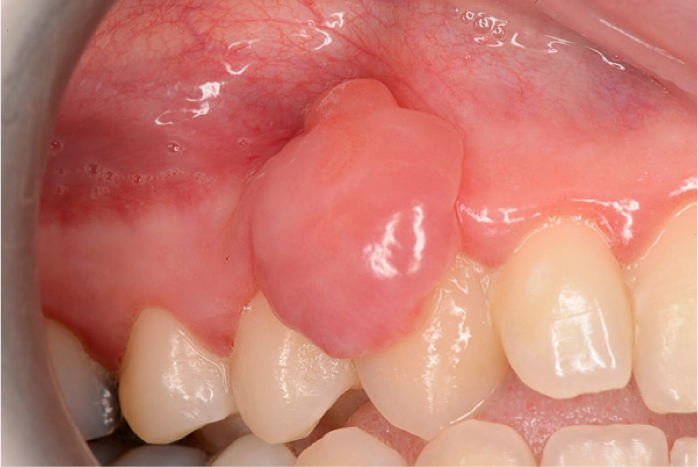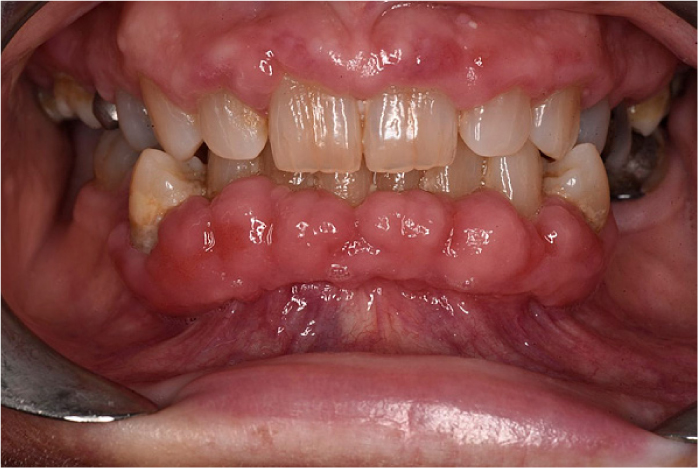| 1 Genetic/developmental disorders |
|
1.1 Hereditary gingival fibromatosis (HGF)
|
|
1.2 Peutz-Jeghers syndrome
|
|
1.3 Cowden syndrome
|
| 2 Specific infections |
|
2.1 Bacterial origin
|
| Necrotizing periodontal diseases (Treponema spp, Selenomonas spp, Fusobacterium spp, Prevotella intermedia, and others) |
| Gonorrhoea (Neisseria gonorrhoeae) |
| Syphilis (Treponema pallidum) |
| Tuberculosis (Mycobacterium tuberculosis) |
| Streptococcal gingivitis (strains of Streptococcus) |
|
2.2 Viral origin
|
| Hand, foot and mouth disease (coxsackie virus) |
| Primary herpetic gingivostomatitis and recurrent herpes simplex (herpes simplex type 1 and 2 virus) |
| Chicken pox and shingles affecting the trigeminal nerve (varicella zoster virus) |
| Kaposi's sarcoma (human herpes virus 8) |
| Molluscum contagiosum (molluscum contagiosum virus) |
| Squamous cell papilloma, condyloma acuminatum, verruca vulgaris, multifocal epithelial hyperplasia (human papilloma virus) |
|
2.3 Fungal origin
|
| Candidosis |
| Other mycoses (histoplasmosis, aspergillosis) |
| 3 Inflammatory and immune |
|
3.1 Hypersensitivity reactions
|
| Contact allergy |
| Plasma cell gingivitis |
| Erythema multiforme |
|
3.2 Autoimmune
|
| Pemphigus vulgaris |
| Mucous membrane pemphigoid |
| Oral lichen planus |
| Lupus erythematosus |
|
3.3 Granulomatous inflammatory conditions
|
| Orofacial granulomatosis and oral Crohn's disease |
| Sarcoidosis |
| Granulomatosis with polyangiitis |
| 4 Reactive processes |
|
4.1 Localized
|
| Fibrous epulis |
| Calcifying fibroblastic granuloma |
| Pyogenic granuloma (vascular epulis) |
| Peripheral or central giant cell granuloma |
| 4.2 Generalized |
| Drug-induced gingival overgrowth |
| 5 Potentially dysplastic and malignant neoplasms |
|
5.1 Potentially dysplastic
|
| Leukoplakia |
| Erythroplakia |
| Erythroleukoplakia |
|
5.2 Malignant
|
| Squamous cell carcinoma |
| Leukaemia |
| Lymphoma |
| Malignant melanoma |
| 6 Nutritional, endocrine and metabolic diseases |
|
6.1 Vitamin deficiencies
|
| Scurvy (vitamin C deficiency) |
|
6.2 Endocrine
|
| Addison's disease |
| 7 Traumatic |
|
7.1 Physical/mechanical insults
|
| Frictional keratosis |
| Toothbrush-induced ulceration |
| Factitious injury (self-harm) |
|
7.2 Chemical (toxic) insults
|
| Etching, chlorhexidine, aspirin (acetylsalicylic acid), cocaine, hydrogen peroxide, dentifrice detergents, paraformaldehyde or calcium hydroxide |
|
7.3 Thermal insults
|
| Burns |
| 8 Other pigmentation |
|
8.1 Physiological
|
| Physiological (ethnicity related) |
| Melanotic macule |
|
8.2 Acquired
|
| Smoker's melanosis |
| Drug induced (including heavy metals) |
|
8.2 Iatrogenic
|
| Amalgam tattoo |
| Graphite tattoo (pencils) |










